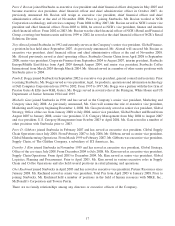Starbucks 2008 Annual Report Download - page 33
Download and view the complete annual report
Please find page 33 of the 2008 Starbucks annual report below. You can navigate through the pages in the report by either clicking on the pages listed below, or by using the keyword search tool below to find specific information within the annual report.
Company-operated retail revenues increased primarily due to the opening of 445 new Company-operated retail
stores in the last 12 months, partially offset by a 5% decrease in comparable store sales for fiscal 2008. The US
Company-operated retail business continued to experience deteriorating trends in transactions during the year,
driven by the US economic slowdown.
Licensing revenues increased primarily due to higher product sales and royalty revenues as a result of opening 438
new licensed retail stores in the last 12 months. Foodservice and other revenues increased primarily due to growth in
new and existing foodservice accounts.
Fiscal Year Ended
Sep 28,
2008
Sep 30,
2007 % Change
Sep 28,
2008
Sep 30,
2007
As a % of US Total
Net Revenues
Cost of sales including occupancy costs ............ $3,371.7 $2,956.2 14.1% 42.8% 40.2%
Store operating expenses
(1)
...................... 3,081.0 2,684.2 14.8 39.1 36.5
Other operating expenses
(2)
..................... 219.6 204.8 7.2 2.8 2.8
Depreciation and amortization expenses ............ 401.7 348.2 15.4 5.1 4.7
General and administrative expenses............... 72.7 85.9 (15.4) 0.9 1.2
Restructuring charges.......................... 210.9 — nm 2.7 —
Total operating expenses ..................... 7,357.6 6,279.3 17.2 93.3 85.4
Income from equity investees .................... (1.3) 0.8 nm — —
Operating income .......................... $ 528.1 $1,070.5 (50.7)% 6.7% 14.6%
(1)
As a percentage of related Company-operated retail revenues, store operating expenses were 44.0% and 40.9%
for the fiscal years ended September 28, 2008 and September 30, 2007, respectively.
(2)
As a percentage of related total specialty revenues, other operating expenses were 24.7% and 26.0% for the
fiscal years ended September 28, 2008 and September 30, 2007, respectively.
Operating margin contracted significantly primarily due to restructuring charges incurred and to softer revenues due
to weak traffic, as well as higher cost of sales including occupancy costs and higher store operating expenses as a
percentage of revenues. Restructuring charges of $210.9 million had a 270 basis point impact on the operating
margin. The increase in cost of sales including occupancy costs was primarily due to higher distribution costs and
higher rent expenses as a percentage of revenues. Higher store operating expenses was due to the softer sales, higher
payroll-related expenditures, and charges from canceling future store sites and asset impairments.
International
The International operating segment sells coffee and other beverages, complementary food, whole bean coffees,
and coffee brewing equipment and merchandise through Company-operated retail stores in Canada, the UK and
nine other markets. Specialty operations primarily include retail store licensing operations in nearly forty other
countries and foodservice accounts, primarily in Canada and Japan. The Company’s International store base
continues to increase and Starbucks expects to achieve a growing contribution from established areas of the business
while at the same time investing in emerging markets and channels. Many of the Company’s International
operations are in early stages of development that require a more extensive support organization, relative to the
current levels of revenue and operating income, than in the United States. This continuing investment is part of the
Company’s long-term, balanced plan for profitable growth.
27
























